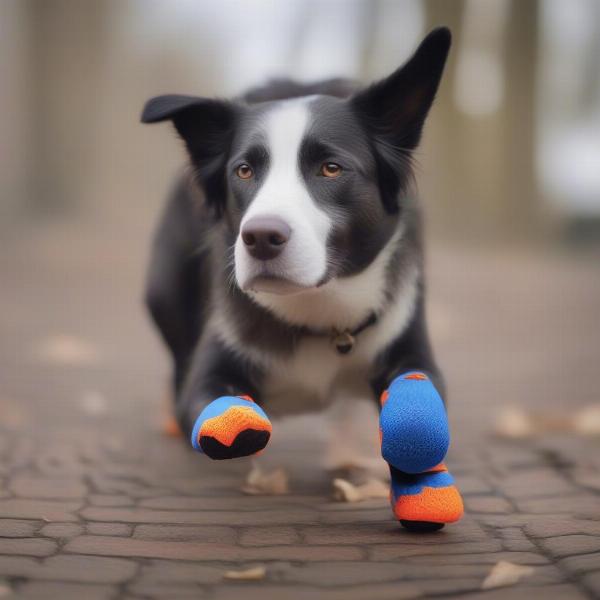Dogs slipping on wood floors is a common problem, especially for energetic breeds or older dogs. This can not only be frustrating for both you and your pet but can also lead to serious injuries like pulled muscles, ligament tears, or even broken bones. Understanding why dogs slip and what you can do to prevent it is key to maintaining their safety and well-being.
Why Do Dogs Slip on Wood Floors?
Wood floors, while beautiful and easy to clean, are notoriously slippery for dogs. Their smooth surface provides little traction for a dog’s paws, especially when running or turning quickly. This lack of grip can make them feel insecure and hesitant to move around freely. Some breeds are also more prone to slipping than others due to their build, leg length, and paw shape. Older dogs, especially those with arthritis or other joint problems, are also at increased risk of slipping and injuring themselves.
Preventing Slips and Falls: Simple Solutions
Fortunately, there are several simple and effective ways to improve traction and prevent your dog from slipping on wood floors. One of the easiest methods is to use area rugs or runners, especially in high-traffic areas like hallways and entryways. Make sure the rugs have a non-slip backing to prevent them from moving around. You can also consider using non-slip floor wax or polish designed specifically for homes with pets. This can significantly increase the grip on your floors without damaging the wood finish.
Paw Protection and Grip Enhancement
In addition to modifying your floors, providing your dog with extra paw protection can also help prevent slipping. Dog socks or booties with rubberized soles offer excellent grip and can be particularly helpful for older dogs or those with existing joint issues. Regularly trimming your dog’s nails can also improve their traction, as long nails can cause them to splay their paws and lose their footing. Keeping your dog’s paw pads moisturized can prevent cracking and dryness, which can also contribute to slipping.
Training and Conditioning for Better Balance
While physical solutions are crucial, training and conditioning can also play a role in improving your dog’s balance and coordination. Encouraging slow, controlled movements on the slippery surface can help them develop better body awareness and foot placement. Simple exercises like walking on a slightly elevated surface or practicing turns can strengthen their leg muscles and improve stability.
 Dog Wearing Grip Socks
Dog Wearing Grip Socks
Choosing the Right Flooring for Your Dog
If you are considering replacing your flooring, opting for a less slippery material can be a long-term solution. Materials like cork, bamboo, or textured tile offer better traction than smooth hardwood. If you love the look of hardwood, consider a matte finish rather than a high-gloss polish, as this can provide slightly more grip.
Conclusion
Addressing your dog’s slipping issues on wood floors is essential for their safety and comfort. By implementing these simple solutions, you can create a more secure environment for your furry friend, reducing their risk of injury and allowing them to move around with confidence. Remember, a proactive approach is always the best way to ensure your dog’s well-being.
FAQ
- What can I put on my wood floors so my dog doesn’t slip? You can use non-slip rugs, runners, or floor wax specifically designed for pet-friendly homes.
- Do dog socks really help with slipping? Yes, dog socks with rubberized soles can significantly improve traction on slippery floors.
- How often should I trim my dog’s nails? Trim your dog’s nails every 1-2 months, or as needed, to maintain proper length and prevent slipping.
- What are the best flooring options for dogs? Cork, bamboo, and textured tile are less slippery than hardwood and offer better traction for dogs.
- Can training help my dog stop slipping? Yes, training can improve your dog’s balance, coordination, and body awareness, reducing the likelihood of slipping.
- Are certain dog breeds more prone to slipping? Yes, some breeds with longer legs or specific paw shapes may be more susceptible to slipping on smooth surfaces.
- What are the risks of a dog slipping on wood floors? Slipping can lead to pulled muscles, ligament tears, and even broken bones in severe cases.
ILM Dog is your one-stop shop for all things dog-related. We offer expert advice on dog breeds, health, training, nutrition, grooming, and much more. Our website features in-depth articles and resources to help you provide the best possible care for your canine companion. Whether you’re a first-time dog owner or a seasoned pro, we have something for everyone. For more information, contact us at [email protected] or call +44 20-3965-8624. Visit ILM Dog today!